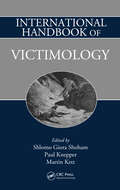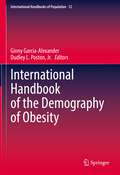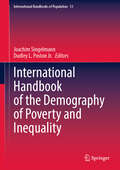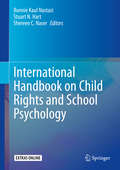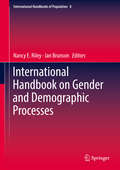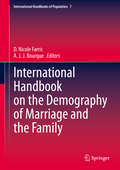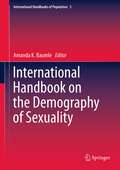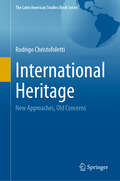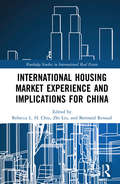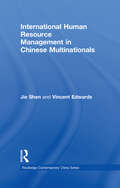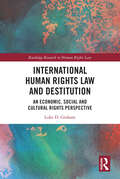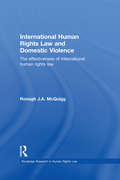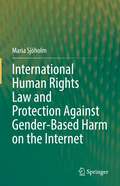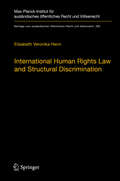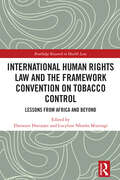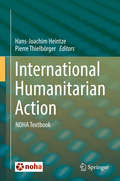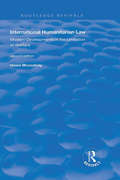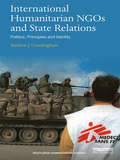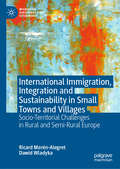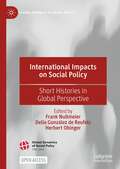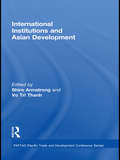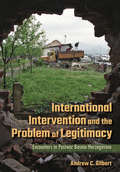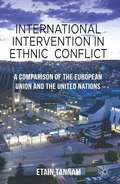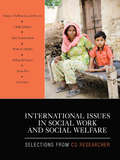- Table View
- List View
International Handbook of Victimology
by Paul Knepper Shlomo Giora Shoham Martin KettIn the nearly four decades since the First International Symposium on Victimology convened in Jerusalem in 1973, some concepts and themes have continued to hold a prominent place in the literature, while new ones have also emerged. Exploring enduring topics such as conceptions of victimhood, secondary and hidden victimization, and social services f
International Handbook of the Demography of Obesity (International Handbooks of Population #12)
by Dudley L. Poston Ginny Garcia-AlexanderThis handbook provides a demographic examination of global obesity trends by bringing together the range of research conducted in this field by demographers, sociologists, epidemiologists, and other quantitatively and demographically oriented social scientists. It utilizes a multidisciplinary demographic approach to provide insights into the global prevalence and mechanisms of obesity, as well as the population level impacts of rising obesity. Major sections include: global obesity trends and prevalence; obesity and demographic structures, processes, and characteristics; emerging areas of study; and obesity in LGBAT populations. This handbook provides readers with a broad understanding of population-based research on obesity and serves as a resource for scholars, students, policymakers, and researchers.
International Handbook of the Demography of Poverty and Inequality (International Handbooks of Population #13)
by Dudley L. Poston Jr. Joachim SingelmannThis handbook provides a comprehensive and comparative review of poverty and inequality in developing and developed countries from demographic, sociological, and political perspectives. It discusses, among others, the basics of poverty and inequality, issues of poverty and inequality among race/ethnic and sexual minority subpopulations, social processes, country and comparative perspectives, child poverty, and anti-poverty policies. It also touches on regional disparities. There has been rapid decline in poverty and inequality in China, East Asian and Pacific countries. Declines have also occurred in South Asia. But in Sub-Saharan Africa, poverty and inequality have risen in some countries, while in other regions, such as transition economies in Europe and Central Asia, only modest changes have occurred. This handbook provides a great reference for demographers, social scientists, policy makers and NGOs.
International Handbook on Child Rights and School Psychology
by Bonnie Kaul Nastasi Stuart N. Hart Shereen C. NaserThis handbook examines the meanings, implications, and transformative potential of a child-rights approach for school psychology. It focuses on the school community, in which psychology is committed to promoting well-being, learning, and development of all children. The handbook begins with an overview of the 1989 United Nations Committee on the Rights of the Child (CRC) and explores main themes such as, survival, protection, development, participation, and nondiscrimination. Chapters provide guidance in promoting and protecting child rights when dealing with critical issues relevant to the school community, including well-being, freedom from violence, and access to high quality education. In addition, chapters analyze and offer recommendations for child rights applications within the roles and responsibilities of school psychologists. The handbook concludes with future directions for achieving a child-rights approach for school psychology. Topics featured in this handbook include:The current status of child rights in the international community.Accountability for child rights by school psychology.Collaborative home, school, and community practices aimed at promoting family support.Protecting child rights within the realm of competitive sports.CRC and school-based intervention programming.Promoting child rights through school leadership.Applying child rights-respecting research to the study of psychological well-being. The International Handbook on Child Rights and School Psychology is a must-have resource for researchers, scientist-practitioners, clinicians, and graduate students in child and school psychology, educational policy and politics, social work, public health, and other school-based or child-serving mental health disciplines.
International Handbook on Gender and Demographic Processes (International Handbooks Of Population Ser. #8)
by Jan Brunson Nancy E. RileyThis handbook presents a comprehensive and up-to-date overview of gender in demography, addressing the many different influences of gender that arise from or influence demographic processes. It collects in one volume the key issues and perspectives in this area, whereby demography is broadly defined. The purpose in casting a wide net is to cover the range of work being done within demography, but at the same time to open up our perspectives to neighboring fields to encourage better conversations around these issues.The chapters in this handbook carefully document definition and measurement issues, and take up parts of the demographic picture and focus on how gender plays a role in outcomes. In other cases, gender often plays a cross-cutting role in social processes; rather than having a single or easily distinguishable role, it often combines with other social institutions and even other statuses and inequalities to affect outcomes. Thus, a key factor in this volume is how gender interacts with race/ethnicity, class, nationality, and sexuality in any demographic setting.While each section contains chapters that are broad overviews of the current state of knowledge and behavior, the handbook also includes chapters that focus on specific cultures or events in order to examine how gender operates in a particular circumstance.
International Handbook on the Demography of Marriage and the Family (International Handbooks of Population #7)
by Karista K. Hughes Elizabeth Harmon ThreattThis handbook provides a global perspective on contemporary demographic theories and studies of marriage and the family. Inside, readers will find a comprehensive analysis that enables demographic comparison between and across international borders. Coverage is centered around four main sections that present a history of marriage and the family, detail relevant data and measurement concerns, examine global marriage practices, analyze interactions of such demographic characteristics as age, sex, and race with marriage and the family, and consider public policy, contemporary trends, and future directions. In addition, the book includes research on current social issues such as alternative family structures, cohabitation, divorce, boomerang children, and adoption. The family is universal but extremely varied in form and function. This handbook provides students, researchers, and policymakers with an all-inclusive, international demographic analysis that fully investigates the diverse nature of the modern family.
International Handbook on the Demography of Sexuality
by Amanda K. BaumleThe International Handbook on the Demography of Sexuality is the first book to specifically address the study of sexuality from a demographic perspective. Demographic research has largely paid little attention to sexuality as a whole, or sexual orientation in particular, other than in studies examining the "consequences" of sex - sexually transmitted infections or fertility. Instead, the content of this handbook explores population sexuality in order to describe the prevalence of sexual behaviors, desires, and identities, as well as their connections with other demographic outcomes. The focus is on analyzing sexuality as a demographic topic in its own right, rather than solely as a variable in studies of sexually transmitted infection or other health-related topics. In this book, both researchers with traditional demographic backgrounds, as well as those with training in other disciplines, provide an overview of the state of current research on population sexuality. These chapters provide a foundation for the development of research in the burgeoning field of the demography of sexuality.
International Heritage: New Approaches, Old Concerns (The Latin American Studies Book Series)
by Rodrigo ChristofolettiThis book celebrates decades of safeguarding cultural heritage and reckons with reconfigurations and shifts that have shaped the field and understandings of it. The author reflects on a career of safeguarding heritage, offering perspectives from the positions of consumer, researcher, educator, and communicator and at a range of scales, from local-level debates to macro-level perspectives on the role of heritage preservation in international relations. The book situates heritage preservation in the context of soft power and the international system and examines how it intersects with cultural diplomacy. These interrelationships crystalize in the illicit trafficking of cultural goods, inspiring reflections on private and common goods, interoperability, and decoloniality. Grounded in nuanced understandings of "world heritage" and "heritage of humanity", the author critically examines the foundation, trajectory, and remit of UNESCO and highlights cases of cultural and natural heritage, language, and tourism. These discussions in turn inform treatments of two timely topics: intangible heritage of and for refugees and the treatment of statues and symbols of colonizers. By integrating diverse themes that are frequently treated independently, International Heritage: New Approaches, Old Concerns is a resource for researchers and practitioners looking to understand the foundations, current debates, and imminent challenges facing communities that aim to safeguard global cultural heritage.
International Housing Market Experience and Implications for China (Routledge Studies in International Real Estate)
by Bertrand Renaud Rebecca L. Chiu Zhi LiuRecent rapid housing market expansion in China is presenting new challenges for policy makers, planners, business people, and citizens. Now that housing in middle-income China is driven by consumer choices and is no longer dominated by state policy decisions, housing policy issues in Chinese cities are becoming increasingly similar to those encountered in other global housing markets. With soaring prices and imbalances in housing supply favoring high income groups and housing demand driven by rising inequality in household incomes, many middle and lower-income households face worsening choices in terms of the quality and location of their housing as well as greater financial difficulties, which together can have negative implications for standards of public health. This book examines the impact of these changes on the general population, as well as on aspiring homeowners and developers. The contributors look at the effect on the widening of wealth gaps, slower economic growth, and threats to political and social stability. Though focusing on China, the editors also present discussions of specific policy design challenges encountered in Australia, Japan, Korea, the Netherlands, the Nordic countries, Singapore, Taiwan, the UK, and the US. This book would be of interest to housing policy makers, as well as academics who are studying the social and political effects of the Chinese housing market.
International Human Resource Management in Chinese Multinationals (Routledge Contemporary China Series #Vol. 12)
by Jie Shen Vincent EdwardsThe authors explore the degree to which Chinese multinationals have a distinctive 'Chinese' approach to human resource management, in the same way as large Japanese companies are widely regarded as having a special Japanese approach. Based on extensive original research in the subsidiaries of Chinese multinationals outside China, the book examines a wide range of issues related to this key question including the evolution of human resource management in Chinese companies, the internationalization of Chinese business, recruitment and selection, rewards and compensation, performance appraisal, strategic integration, and employee relations. Shen and Edwards give a detailed account of the international human resource management of Chinese multinational enterprises; a topic of increasing significance in understanding global economic affairs.
International Human Rights Law and Destitution: An Economic, Social and Cultural Rights Perspective (Routledge Research in Human Rights Law)
by Luke D. GrahamThis book explores destitution from the perspective of International Human Rights Law and, more specifically, Economic, Social and Cultural Rights. The experience of destitution correlates to the non-realisation of a range of economic, social and cultural rights. However, destitution has not been defined from this perspective. Consequently, the nexus between destitution and the denial of economic, social and cultural rights remains unrecognised within academia and policy and practice. This book expressly addresses this issue and in so doing renders the nexus between destitution and the non-realisation of these rights visible. The book proposes a new human-rights-based definition of destitution, composed of two parts. The rights which must be realised– the component rights – and the level of realisation of these rights which must be met – the destitution threshold – to avoid destitution. This human rights-based understanding of destitution is then applied to a UK case study to highlight the relationship between government policy and destitution, to illustrate how destitution manifests itself, and to make recommendations – founded upon engendering the realisation of economic, social and cultural rights – aimed towards addressing destitution. This book will have global and cross-sectoral appeal to anti-poverty advocates, policy makers, as well as to researchers, academics and students in the fields of human rights law, poverty studies, and social policy.
International Human Rights Law and Domestic Violence: The Effectiveness of International Human Rights Law (Routledge Research in Human Rights Law)
by Ronagh J.A. McQuiggThis innovative book examines the effectiveness of international human rights law, through the case study of domestic violence. Domestic violence is an issue that affects vast numbers of women throughout all nations of the world, but as it takes place between private individuals it does not come within the ambit of the traditional interpretation of human rights law. Ronagh J.A. McQuigg questions whether international human rights law can only be effective in a ‘traditional’ case of human rights abuse or whether it can rise to the challenge of being used in relation to issues such as domestic violence. The book focuses primarily on the question of how international human rights law could be used in relation to domestic violence in the United Kingdom. McQuigg considers recent case law from the European Court of Human Rights on domestic violence and whether the UK courts could use the Human Rights Act 1998 to assist victims of domestic violence. The book goes on to look in detail at the statements of the international human rights bodies on domestic violence, with particular focus on those made by the United Nations Committee on the Elimination of Discrimination against Women and the Special Rapporteur on Violence against Women. The book explores the impact that the statements have had so far on the UK government’s policy in relation to domestic violence and discusses how the statements made by the international human rights bodies could be used more effectively by non-governmental organisations, such as human rights groups and women’s groups.
International Human Rights Law and Protection Against Gender-Based Harm on the Internet
by Maria SjöholmThis book analyses gender-based offences on the Internet from the perspective of international human rights law, interwoven with rights theories and feminist legal theories. It investigates whether international human rights law is applicable in regulating harmful online conduct and speech, with a focus on sexual violence, various forms of harassment, sexist hate speech and harmful pornography. This involves assessing whether gender-based online offences are considered violations of international human rights law and – if they are recognised as such explicitly or by way of interpretation – the extent of state obligations. The book reviews a range of international law sources, such as selected international human rights law treaties, case law, soft-law documents and academic scholarship. The application of general human rights law provisions to the online sphere is evaluated by considering the online/offline coherence of provisions as well as potential gaps, inconsistencies and disadvantages that exist in the regulation of online gender-based offences. The makeup, aim and effect of social spheres, areas of law and legal principles are thus assessed in relation to gender and the Internet. Aspects discussed include the architecture of the Internet, the structure of public international law, the harm principle as employed in domestic law and international human rights law, and the scope of particular rights, mainly involving the freedom of expression and the right to privacy. Working from the premise that the transposition of international human rights law to the Internet must ensure the former’s functionality and effectiveness, the book argues that a contextual application of rights is called for. This requires assessing what is harmful online – including the effects of online speech and conduct - and what are effective means of regulating liability on the Internet. In turn, such assessments require a gender-sensitive approach.
International Human Rights Law and Structural Discrimination: The Example of Violence against Women (Beiträge zum ausländischen öffentlichen Recht und Völkerrecht #280)
by Elisabeth Veronika HennInternational courts and other actors are increasingly taking into account pre-existing social structures and inequalities when addressing and redressing human rights violations, in particular discrimination against specific groups. To date, however, academic legal research has paid little attention to this gentle turn in international human rights law and practice to address structural discrimination. In order to address this gap, this study analyses whether and to what extent international and regional human rights frameworks foresee positive obligations for State parties to address structural discrimination, and, more precisely, gender hierarchies and stereotypes as root causes of gender-based violence. In order to answer this question, the book analyses whether or not international human rights law requires pursuing a root-cause-sensitive and transformative approach to structural discrimination against women in general and to the prevention, protection and reparation of violence against women in particular; to what extent international courts and (quasi)judicial bodies address State responsibility for the systemic occurrence of violence against women and its underlying root causes; whether or not international courts and monitoring bodies have suitable tools for addressing structural discrimination within the society of a contracting party; and the limits to a transformative approach.
International Human Rights Law and the Framework Convention on Tobacco Control: Lessons from Africa and Beyond (Routledge Research in Health Law)
by Ebenezer Durojaye Lucyline Nkatha MurungiThis book reviews the challenges and opportunities in the implementation of the WHO Framework Convention on Tobacco Control (FCTC) at the regional and national levels in Africa. It contains an analysis of the relevant norms and monitoring mechanisms at the regional level, and case studies from selected African and other developing countries. The WHO has noted that tobacco use or exposure to tobacco is a major health risk factor for non-communicable diseases (NCDs). This volume highlights the importance of taking measures to control tobacco use in Africa with a view to preventing these risks. With contributions from experts from the Global South, the book provides a critical analysis of the role that human rights can play in mitigating the impact of tobacco use and NCDs, and the implementation of the FCTC. The book contains a systematic and in-depth analysis of how efforts to realise the right to health under international and regional law can help to address the incidence of tobacco use in the developing world. The collection will be an important resource for academics, researchers and policymakers working in the areas of public health law and international human rights.
International Human Rights: Universalism Versus Relativism (Frontiers of Anthropology #6)
by Alison Dundes RentelnThe universality of international human rights has been an enduring issue. This volume argues that the positions of universalists and cultural relativists are not diametrically opposed and that it is possible to demonstrate, empirically and cross-culturally, the existence of worldwide human rights.
International Humanitarian Action
by Pierre Thielbörger Hans-Joachim HeintzeThis textbook examines a wide range of humanitarian action issues, presented by specialists from different academic fields in five chapters. The respective chapters reflect the five core modules of the International Master Program "International Humanitarian Action" (NOHA), which have been jointly defined by researchers at the NOHA universities and consist of a) Geopolitics in Humanitarian Action, b) Anthropology in Humanitarian Action, c) International and Human Rights Law, d) Public Health and Medicine, and e) Management in Humanitarian Action. The book represents the common basis for teaching at all NOHA universities and aims at providing the knowledge and skills needed to excel in a complexinterdisciplinary and international learning context. It provides in-depthinformation on key international humanitarian principles and values, professional codes of conduct, and the commitment to their implementation in practice.
International Humanitarian Law: Modern Developments in the Limitation of Warfare (Routledge Revivals)
by Hilaire McCoubreyFirst Published in 1998, this book presents an analysis of international humanitarian law, the law governing and seeking to mitigate the conduct of armed conflict. Since the first edition of this work came out in 1990 there have been important developments in the law and, sadly, a continuing experience of armed conflict and the humanitarian crises which it represents. As a result, this is not so much an ‘updating’ as the offering of a new book. International humanitarian law is here taken as coterminous with the jus in bello and covers both its ‘Geneva’ and ‘Hague’ elements dealing, respectively with the humanitarian protection and assistance of victims of armed conflict and the controls and restrictions placed upon methods and means of warfare. The rules and principles of international humanitarian law are presented and analysed in the context of their practical application in warfare, with emphasis upon recent experience. The Work is Primarily dedicated to the law relating to international armed conflict but also includes discussion of the relevant law applicable to non-international and ‘low level’ conflict.
International Humanitarian NGOs and State Relations: Politics, Principles and Identity (Routledge Humanitarian Studies)
by Andrew J. CunninghamInternational Humanitarian NGOs and State Relations: Politics, Principles and Identity examines the often discordant relationship between states and international non-governmental organisations working in the humanitarian sector. INGOs aiming to provide assistance to populations suffering from the consequences of conflicts and other human-made disasters work in the midst of very politically sensitive local dynamics. The involvement of these non-political international actors can be seen as a threat to states that see civil war as a state of exception where it is the government’s prerogative to act outside ‘normal’ legal or moral boundaries. Drawing on first-hand experience of humanitarian operations in contexts of civil war, this book explores how the relationship works in practice and how often clashing priorities can be mediated. Using case studies of civil conflicts in Sri Lanka, Darfur, Ethiopia and Chechnya, this practice-based book brings together key issues of politics, principles and identity to build a ‘negotiation structure’ for analysing and understanding the relationship. The book goes on to outline a research and policy development agenda for INGOs to better adapt politically to working with states. International Humanitarian NGOs and State Relations will be a key resource for professionals and policy makers working within international humanitarian and development operations, as well as for academics and students within humanitarian and development studies who want to understand the relationship between states and humanitarian and multi-mandate organisations.
International Immigration, Integration and Sustainability in Small Towns and Villages: Socio-Territorial Challenges in Rural and Semi-Rural Europe (Migration, Diasporas and Citizenship)
by Ricard Morén-Alegret Dawid WladykaThis book brings small places to the main stage in an exploration of the nature of immigration in rural areas and small towns in Europe. Extending recent efforts to study migration at a sub-national scale, the authors focus their analysis on non-metropolitan areas to consider how globalisation and modernisation processes are experienced at a local level. Morén-Alegret and Wladyka weave themes of livelihood, social participation, justice and equity into human and planetary sustainability debates, drawing on quantitative population data as well as qualitative information on challenges for rural and small town sustainability in four different European countries (Portugal, France, Spain and England).Highlighting the interlinked relationship between rural sustainability, migration and ethnic diversity, this research is a valuable resource for policy-makers and academics alike, with far-reaching implications across geography, sociology, political science, anthropology and environmental sciences.
International Impacts on Social Policy: Short Histories in Global Perspective (Global Dynamics of Social Policy)
by Herbert Obinger Frank Nullmeier Delia González de ReufelsThis open access book consists of 39 short essays that exemplify how interactions between inter- and trans-national interdependencies and domestic factors have shaped the dynamics of social policy in various parts of the world at different points in time. Each chapter highlights a specific type of interdependence which has been identified to provide us with a nuanced understanding of specific social policy developments at discrete points in history. The volume is divided into four parts that are concerned with a particular type of cross-border interrelation. The four parts examine the impact on social policy of trade relations and economic crises, violence, international organisations and cross-border communication and migration. This book will be of interest to academics and postgraduate students in the field of social policy, global history and welfare state research from diverse disciplines: sociology, political science, history, law and economics.
International Institutions and Economic Development in Asia (PAFTAD (Pacific Trade and Development Conference Series))
by Shiro ArmstrongAre international and Asian regional institutions serving the development goals of Asian and Pacific Economies as well they should? The global economy, led by the Asia Pacific region, has undergone immense change and growth. Have the existing institutions and arrangements been able to keep pace with those changes in the global economy? International Institutions and Asian Development tackles these questions and is an essential book for the assessment of regional and international institutions, as well as policy prescriptions for reforming them to ensure they deliver on sustainable, peaceful growth and development in the region. Drawing from papers presented to the 32nd Pacific Trade and Development conference in Hanoi in 2007, the contributions by distinguished authors add to the understanding of the purpose, evolution, relevance and gaps in regional and global institutions and their arrangements. Shiro Armstrong is a Research Fellow at the Crawford School of Economics and Government at the Australian National University. Vo Tri Thanh is Director of the Department for International Economic Integration Studies of the Central Institute of Economic Management in Vietnam
International Intervention and the Problem of Legitimacy: Encounters in Postwar Bosnia-Herzegovina
by Andrew GilbertIn International Intervention and the Problem of Legitimacy Andrew C. Gilbert argues for an ethnographic analysis of international intervention as a series of encounters, focusing on the relations of difference and inequality, and the question of legitimacy that permeate such encounters. He discusses the transformations that happen in everyday engagements between intervention agents and their target populations, and also identifies key instabilities that emerge out of such engagements. Gilbert highlights the struggles, entanglements and inter-dependencies between and among foreign agents, and the people of Bosnia-Herzegovina that channel and shape intervention and how it unfolds.Drawing upon nearly two years of fieldwork studying in postwar Bosnia and Herzegovina, Gilbert's probing analysis identifies previously overlooked sites, processes, and effects of international intervention, and suggests new comparative opportunities for the study of transnational action that seeks to save and secure human lives and improve the human condition.Above all, International Intervention and the Problem of Legitimacy foregrounds and analyzes the open-ended, innovative, and unpredictable nature of international intervention that is usually omitted from the ordered representations of the technocratic vision and the confident assertions of many critiques.
International Intervention in Ethnic Conflict
by Etain TannamThe EU and the UN have become increasingly involved in conflict resolution, yet they are rarely compared systematically. This book focuses on the role of bureaucracies in the European Union (EU) and the United Nations (UN) when dealing with conflict. Tannam's comparative analysis of EU and UN policy-making procedures explores how and why they differ from each other, arguing that the UN Secretariat and the European Commission have autonomy under certain conditions and that reducing explanations of EU and UN policy outcomes to political will, or to the preferences of member states is inaccurate. This unique empirical study, enhanced by interviews with practitioners, will be a valuable resource for scholars of International Relations, Peace Studies and Comparative Politics.
International Issues in Social Work and Social Welfare: Selections From CQ Researcher
by Cq ResearcherWhat is human trafficking, and where does it occur?How have other nations exploited children as child soldiers, and what can be done about it?Have violence and discrimination against women increased or decreased globally over the past decade?The collection of articles in International Issues in Social Work and Social Welfare addresses these questions and many more. The articles encourage lively classroom discussion and debate and bring pressing international issues into the classroom for almost any course across the social work curriculum, as required by the new guidelines set forth by the Council on Social Work Education.About CQ Researcher ReadersIn the tradition of nonpartisanship and current analysis that is the hallmark of CQ Press, CQ Researcher readers investigate important and controversial policy issues. Offer your students the balanced reporting, complete overviews, and engaging writing that CQ Researcher has consistently provided for more than 80 years. Each article gives substantial background and analysis of a particular issue as well as useful pedagogical features to inspire critical thinking and to help students grasp and review key material:A pro/con box that examines two competing sides of a single questionA detailed chronology of key dates and eventsAn annotated bibliography that includes Web resourcesAn outlook section that addresses possible regulation and initiatives from Capitol Hill and the White House over the next 5 to 10 yearsPhotos, charts, graphs, and maps
